Category Archives: Uncategorized
News
NEW REPORT: Articulating a Next Generation Vision for Sustainable Urban Systems Research to NSF
The Advisory Committee on Environmental Research and Education (AC-ERE) to the US National Science Foundation (NSF) has released a new report articulating a next generation vision for sustainable urban systems research. Read the full report here.
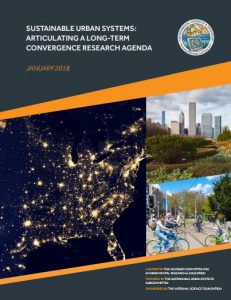
In 1950, fewer than one-third of the world’s people lived in cities. By 2050, urban areas will be home to some two-thirds of Earth’s human population. This scale and pace of urbanization has never been seen in human history and requires a new type of science that transcends traditional disciplines and that intentionally links from intra-urban to urban-regional to global scales. No single discipline, from urban planning to public policy to engineering has the scope to address this challenge. Scientists need new data, methods and theories to assess the interactions among people, policy, infrastructure, technologies, governance institutions, and natural systems to understand urban to global system functions and change.
The AC-ERE released the report in response to this broader landscape and the challenges therein. The report seeks to provide a long-term vision to guide NSF and other funding agencies as they invest in new science and science-to-action partnerships moving from an exclusive focus on cities to a focus on sustainable urban systems.
The report was prepared by the Sustainable Urban Systems subcommittee to the AC-ERE, chaired by Anu Ramaswami, director of the Sustainable Healthy Cities Network and professor at the Humphrey School of Public Affairs. See the full press release from NSF here.
News
NEW REPORT: Two UN Environment Reports Launched: The Weight of Cities (Global) and Sustainable Infrastructure Transitions in the ASEAN (Southeast Asia)
Can we better design cities to support local and global sustainability goals? That is the subject of two new reports recently released by UN Environment including a global report, The Weight of Cities: Resource Requirements of Future Urbanization, and a regional report for Southeast Asia, Sustainable Urban Infrastructure Transitions in the ASEAN Region: A Resource Perspective.
Both reports call for new strategies to meet the needs of 21st-century urbanization, ones that will result in cities that are low carbon, resource efficient, socially just, and in which people can live healthy lives. Read UN Environment’s full press release here.
Policy-maker summaries for both reports were recently launched at UN Habitat’s 9th World Urban Forum. The summary of the global report can be found here. The summary of the regional Southeast Asia report can be found here.
Anu Ramaswami, director of the Sustainable Healthy Cities Network, was a contributing author to the global report and lead author of the regional report. Sustainable Healthy Cities Network staff researchers Ashly McFarlane and Sam Tabory, as well as post-doctoral fellow Rylie Pelton, were contributing authors to the regional report.
Both reports were developed by UN Environment as part of their ongoing efforts to promote resource efficient urbanization. Learn more about the work of UN Environment’s Global Initiative for Resource Efficient Cities here.
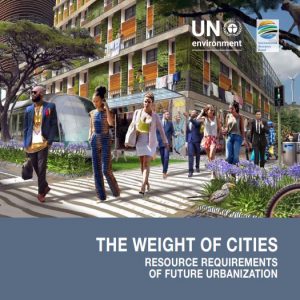
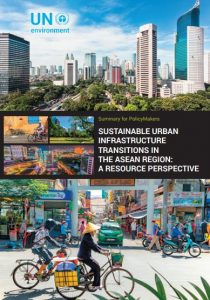
News
POLICY ENGAGEMENT: Ecological Landscapes in Cities at the World Urban Forum
How can connections between the built environment, natural ecosystems, and urban metabolism be leveraged in cities to advance both local and global sustainability targets? That is the question that Anu Ramaswami, director of the Sustainable Healthy Cities Network and professor at the Humphrey School of Public Affairs, was tasked with helping to answer as a speaker at UN Habitat’s plenary session on Ecological Landscapes in Cities at the 9th World Urban Forum in Kuala Lumpur, Malaysia.
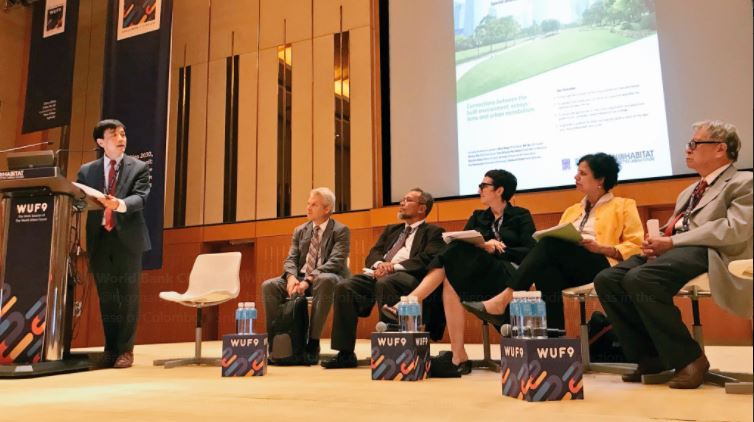
Ramaswami joined speakers from the Word Bank, UN Habitat, UN Environment, the Government of Malaysia, the Mayor of Quito and civil society and youth representatives to discuss the role of landscapes as mediators between urban built environments and natural landscapes.
Panelists discussed the need to simplify urban metabolism models as a way to engage youth champions in the cause of sustainability, the role that green and blue spaces in cities will play in addressing challenges of climate change adaptation, and the general benefits to biodiversity and resilience that ecosystem services in cities are able to offer residents.
Ramaswami presented leading edge research from the Sustainable Healthy Cities Network quantifying the impact of urban infrastructure sectors and food supply on regional land and water resources, their contributions to global greenhouse gas emissions, and their role in broadly shaping human health and wellbeing, in turn affecting almost all of the UN’s Sustainable Development Goals. She also spoke of how the work is informing a new urban systems research frontier in which scientists are able to model comprehensive sustainability scenarios across multiple infrastructure sectors in individual cities, ultimately connecting those results to higher-level models that look at the impact of all urban areas in a country or region.
The plenary session highlighted the importance of ongoing research and policy engagement to promote resource efficient cities. The panel was hosted by UN Habitat’s Greener Cities Partnership, a collaboration between UN Habitat and UN Environment. More from UN Habitat and the Greener Cities Partnership can be found here. More from UN Environment on resource efficient cities can be found here.
News
NEW STUDY: Design Strategies for Maximizing Stormwater Capacity of Urban Tree Pits
Sustainable Healthy City researchers Patricia Culligan and Robert Elliott of Columbia University have co-authored a new study looking at design and management strategies to maximize the stormwater management capacity of tree pits. See coverage of the study as published by Columbia News below. Read the full study in the journal Ecological Engineering.

So Much Depends on a Tree Guard
News
COMMENTARY: Six Principles for Energy Innovation
Sustainable Healthy Cities researcher Gabe Chan has co-authored a commentary piece about key principles of energy innovation in the journal Nature. An excerpt of the commentary as published by the Humphrey School of Public Affairs is below. Read the full commentary from Nature.

December 6, 2017—
Last month, the European Union marked the tenth year of its Strategic Energy Technology Plan. It is one of many policy initiatives worldwide to accelerate innovation in energy technologies to reduce greenhouse gas emissions. As the window of opportunity to avert dangerous climate change closes, we urgently need to take stock of these initiatives—what works and why?
Public investments in energy research, development, and demonstration (RD&D) have risen since the low levels of the mid-1990s and early 2000s. In 2016, member countries of the Organisation for Economic Co-operation and Development spent US$16.6 billion on energy RD&D, compared with $10 billion in 2000 (adjusted for purchasing power parity). In October, the United Kingdom set out its Clean Growth Strategy to invest more than £2.5 billion ($3.3 billion) in low-carbon innovation between 2015 and 2021. In 2015, the EU and 22 nations pledged to double their investment in energy RD&D under the Mission Innovation adjunct to the Paris climate agreement. However, the overall goal might be out of reach given the proposed 35% cut in President Donald Trump’s 2018 budget for energy RD&D.
Different nations are pursuing various strategies and creating new types of institution. For example, the Advanced Research Projects Agency-Energy (ARPA-E) run by the US Department of Energy (DOE) targets grants at key technologies such as affordable energy storage. The DOE Energy Innovation Hubs form research teams to work on technologies such as nuclear reactor modelling.
The United Kingdom has set up the Energy Technologies Institute (ETI), a public–private partnership to accelerate the development of low-carbon technologies. It also launched the Catapult programme, which aims to build bridges between universities and industry, and sustainability advisory services that are run by bodies such as the Carbon Trust. And China is reforming the Chinese Academy of Sciences and its national labs, as well as creating larger lab facilities.
At the international level, the United Nations Framework Convention on Climate Change (UNFCCC) Technology Mechanism enables technology development and transfer in developing countries to support the Paris agreement. Since 2013, the World Bank Group has opened seven climate-innovation centres in developing countries such as Kenya. The centres provide seed financing, policy guidance, networking and technical training. The Nairobi centre, for example, advises startups such as Futurepump, which is developing solar-powered water pumps.
Most of these bodies can claim successes. But a comprehensive global assessment of energy innovation programs is needed to learn from collective experience and to establish best practices. As a starting point, we recommend six principles to guide public initiatives for energy innovation.
Gabe Chan is an assistant professor at the University of Minnesota’s Humphrey School of Public Affairs. He is an affiliated faculty researcher with the Sustainable Healthy Cities Network.
News
NEW STUDY: Cities Can Play Important Role in Reducing Environmental Impact of Food Systems
A new study published by SRN researchers in the the journal Environmental Science & Technology introduces a methodology for understanding the impact that city-level policy can have on reducing the overall environmental impact of food systems. See complete findings here.
On global and national scales, the food system is known to have substantial environmental impact, with estimates as high as 85% of global water use and 30% of global greenhouse gas emissions. Yet cities, despite being such large centers of population and food use, remained largely absent from the discussion of how to mitigate these large environmental impacts. The food system has traditionally not been considered a common concern of municipalities, particularly in comparison to other infrastructure sectors, thus the metrics and tools to assess city-level change within the food system are substantially lacking.
Only recently have cities begun reemerging as players in the global food system grappling with food system concerns ranging from health and nutrition of their residents, equity of access, resilience, and environmental sustainability. Evidence of this is seen in recent efforts by global food organizations, including the United Nations Food and Agriculture Organization’s Food for the Cities, C40’s Food Systems Network and the Milan Food Pact, all working to mobilize city-scale food system actions. Examples from the Minneapolis-St. Paul Metropolitan area include the Minneapolis Food Policy Council, Homegrown Minneapolis, a non-profit organization, as well as the City of St Paul through its work to improve food access.
Yet with such a diversity of urban food concerns, the science is lacking to assess the tradeoffs and co-benefits of various city-level actions that affect food policy and food systems. For example, if a city aims to promote a particular diet for improved health, does this complement or conflict with efforts to lessen overall environmental impact?
While the water, energy/greenhouse gas (GHG) and land impact of the global food system has been studied on national and global scales, this paper focuses on actions taken at the city scale that have received little attention. The paper presents a systems methodology to address the important question of: what is the extent to which city-scale actions shape the overall food system’s environmental impact, specifically in terms of GHG, water, and land?
The methodology helps to identify which food systems strategies are co-beneficial and where tradeoffs must be considered in terms of water, energy, GHG and other social impacts (i.e. greater equity, increasing nutrition). The methodology presented is applicable to any city with the requisite data. As cities increasingly emerge as prominent players in the global food system, this research helps cities to understand, quantitatively, their actions in the context of resource constraints and planetary boundaries.
Applied to Delhi India, the work explores future urban food scenarios related to: a) diet-related equity and health; b) sustainable diet change; c) greater local food production through various modes of urban agriculture (soil-based, vertical); d) improved food waste management and e) cooking fuel interventions.
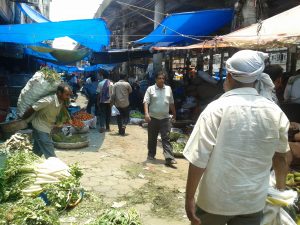

The analysis demonstrates that city-scale action can rival typical food policy interventions that occur at larger scales, although no single city-scale action can rival in all three environmental impacts. In particular, improved food-waste management within the city (7% system-wide GHG reduction) matches the GHG impact of pre-consumer trans-boundary food waste reduction. The systems approach is particularly useful in illustrating key tradeoffs and co-benefits. For instance, multiple diet shifts that can reduce GHG emissions have trade-offs that increase water and land impacts. Vertical farming technology with current applications for fruits and vegetables can provide modest system-wide water (4%) and land reductions (3%), although implementation within the city itself may raise questions of constraints in water-stressed cities, with such a shift in Delhi increasing community-wide direct water use by 16%. Improving the nutrition status for the bottom 50% of the population to the median diet is accompanied by proportionally smaller increases of water, GHG, and land impacts (4%, 9%, and 8%, system-wide): increases that can be offset through simultaneous city-scale actions, e.g., improved food-waste management and vertical farming technologies.
The study, “What Is the Contribution of City-Scale Actions to the Overall Food System’s Environmental Impacts?: Assessing Water, Greenhouse Gas, and Land Impacts of Future Urban Food Scenarios” is published in the journal Environmental Science and Technology by Dana Boyer (PhD Candidate, Science, Technology and Environmental Policy) and Anu Ramaswami (Professor, Denny Chair) of the Center for Science, Technology and Environmental Policy at the Humphrey School of Public Affairs. See the complete findings here.




